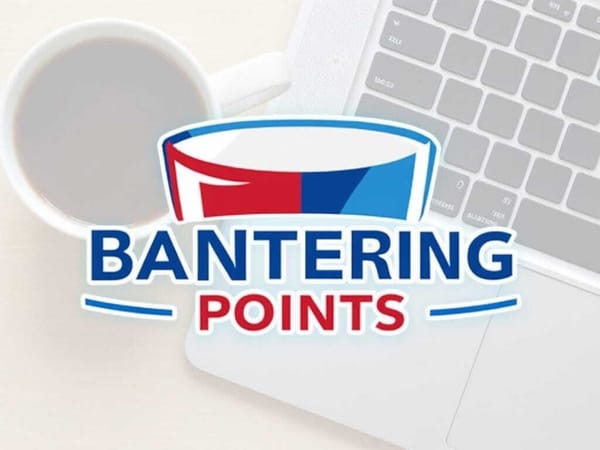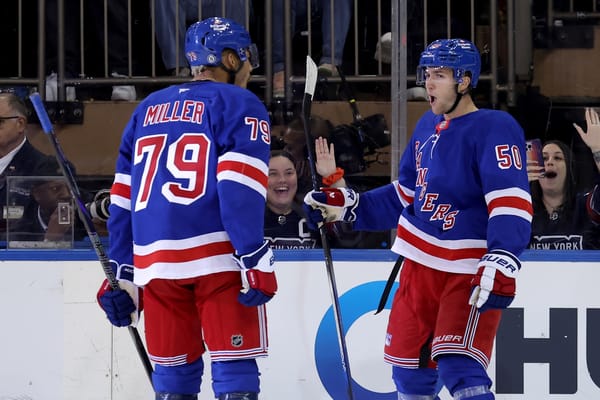Four Rangers-centric stories to pitch to Netflix
Or ESPN’s 30 for 30, or whatever
Last week, Michelle Jay at The Ice Garden pitched four women’s hockey stories that Netflix should consider for feature films or mini-series after the streaming titan announced plans for a movie about the 1999 U.S. women’s soccer team and their unforgettable victory in the 1999 World Cup. I really liked the idea, so I decided to steal it.
The New York Rangers have been around since 1926, which pre-dates the invention of radar, Scotch tape, and penicillin. That’s old. If the Rangers were a kindly old grandpappy, they could spin yarns for hours by the fire whilst occasionally using terms and phrases that are no longer socially acceptable and offering hard candy that may or may not have been a keepsake from an MRE opened during the Battle of the Bulge.
So, there’s a lot of stories to choose from. So much so that this has the potential to become a mini-series of its own. But, before we get there, let’s start things off with three of my favorite stories from Rangers’ history.
The Desperation of Frank Boucher
Back in Aug. 2016, I wrote a guest piece for Puck Daddy of Yahoo! Sports in their “Weird NHL” series. My favorite story from that article came from the 1950-51 season, in which a desperate Frank Boucher, then general manager of the Rangers, turned to a charlatan and hypnotist named Dr. David Tracy to turn their season around after a dozen consecutive losses.
Dr. Tracy hypnotized most of the team and the Rangers lost their 13th straight game. So, Boucher asked his buddy and restaurateur Gene Leone to give his professional athletes a mystery substance in a black bottle to cure their losing ways. This shit actually happened.
From my story for Puck Daddy:
Apparently Leone, like so many celebrity potion-makers, wasn’t always on the ball with making his swill. When the Rangers lost road games because Leone’s Elixir wasn’t there people, especially Burchard, freaked out.
Hockey historian Stan Fischler believes that the elixir was either “clam juice or broth and a few other items.” Others believe it was a mixture of ginger ale, orange juice, and honey. Whatever it was, it was apparently disgusting to drink and some Rangers could only handle gargling it before spitting it out.
Remember, this is a professional sports team we’re talking about. The same team that many believe is “too classy” to have a mascot.
The Rangers finished the 1950-51 season with a record of 20-29-21 and, in all likelihood, some fascinating bowel movements.
Blocker Down
Last month, Blueshirt Banter’s Kevin Power wrote about Dan Blackburn in his “Forgotten Future” series, so I won’t dive into too much detail with this one.
From Kevin’s story:
During the 2003 offseason, right before Rangers camp was set to open, Dan Blackburn suffered a freak shoulder injury while lifting weights. The injury turned out to be a severe nerve issue in Blackburn’s left shoulder that prevented him from fully closing his hand, thus leaving him unable to close his glove when stopping a puck.
The Rangers have no shortage of what-ifs tied to significant injuries and to tragedies like the deaths of Alexei Cherepanov, Roman Lyashenko, Derek Boogaard, and so many others. Blackburn’s story stands out not only because his career was over before it truly began, but because of his unique attempt to make a comeback from his injury by using two blockers.
There’s more to this story than necessity being the mother of invention. Blackburn was the fifth-youngest goalie in NHL history when he made his debut in the 2001-02 season. Just a few years later, he mounted a comeback with a disability and played professional hockey in the ECHL with Victoria Salmon Kings.
“This is basically just one big experiment for me,” Blackburn told ESPN back in 2005. “I’m 95 percent of the same goalie I was before I got hurt. Everything is the same except my arm, and I’m determined to work around my disability ... It’s been a life-altering situation.”
Of course, Blackburn never made it back to the NHL. He retired at the age of 22, forcing him to think about life after hockey long before most players who were drafted 10th overall.
The final act of the film or mini-series writes itself. Blackburn played for the Rangers in the Alumni Game at the 2011 Winter Classic and made several big saves. It’s the kind of sports story that can give you chills.
Frontier Hockey: Blood and Wood
Back before we had color TV, stick fights were things that sometimes happened in hockey games. My favorite resource for old-time hockey anecdotes is Stan Fischler and few people can tell a the story of a stick fight like The Maven. Here is his recollection of one of hockey’s most infamous stick-swinging duels between Ranger Ron Murphy and Montreal Canadien Boom Boom Geoffrion.
“It was completely different; it was meaner,” Stan Fischler said on an episode of the Puck Soup podcast in April 2018. “The high-sticking, which was very frequent, was nasty. Of course, if Gordie Howe was playing now he’d be in jail for all of the damage he did — and I saw a lot of damage. I thought Ronnie Murphy of the Rangers was gonna get killed — or got killed when Bernie Geoffrion poleaxed him.”
View post on imgur.com
It’s not often you hear or read the verb “poleaxed” but it definitely applies here. In the aforementioned podcast, Fischler also tells the story of Jack “Tex” Evans who took part in the greatest stick fight in hockey history in the 1950s while he was playing with the Saskatoon Quakers, the Rangers’ WHL affiliate.
Evans squared off with Larry “The Rock” Zeidel — this is back when nicknames were more than just adding “-er” or “-ey” to the first syllable of a player’s last name — who was playing for the Edmonton Flyers. The two defensemen got into a stick fight, you know, like you do, and after breaking their sticks over each other’s noggins things got even more barbaric. They went after each other with the jagged, splintered ends of their sticks, painting the ice red with blood. Can you imagine being an official when something like this was happening? They required about 19 stitches each after performing improvised plastic surgery on each other.
“Tex” is the Ranger in the top left of the picture below. Alarmingly, he has more teeth than his three teammates.
A look back at hockey’s violent transition from a frontier game into the game it is today would be a pretty fascinating documentary. Of course, all four major North American sports have undergone drastic changes, but hockey’s history was painted blood red long before it became the game of speed and skill that we know today.
Done Deal: The World for Eric Lindros
For many, the biggest trade in hockey history was the one that sent Wayne Gretzky to the Los Angeles Kings, but it has some competition. This one has to be a 30 for 30, if not a full-on documentary.
After refusing to sign with the Quebec Nordiques following the 1991 NHL Draft, the future of highly-touted prospect Eric Lindros was decided by Larry Bertuzzi, an arbitrator appointed by the NHL, as a result of the Nordiques accepting trades from both the Philadelphia Flyers and the New York Rangers. The confusing and grueling arbitration process took a week — a week in which the entire hockey world held its breath.
The arbitrator ruled in favor of the Flyers, which resulted in the big center playing for Philly in exchange for Steve Duchesne, Peter Forsberg, Ron Hextall, Kerry Huffman, Mike Ricci, Chris Simon, two draft picks, and $15 million. Yeah, that’s a lot. New York Rangers’ general manager Neil Smith’s offer was just as over-the-top.
There are conflicting reports about what offer from the Rangers’ the Nordiques accepted — the Rangers had pursued the pick that would become Lindros six months prior to the accepted deal(s) — but Smith was willing to give up heaven and earth to break the team’s Cup drought. The four pieces in the deal that Quebec accepted were reportedly Tony Amonte, Alex Kovalev, Doug Weight, James Patrick, John Vanbiesbrouck or Mike Richter, three first round picks, and $12 million. According to interview on ESPN 97.3 in 2018, Smith claimed that Rangers offered $12 million up front to the Nordiques and the Flyers offered $15 million spread out across a few years. He didn’t remember the minutiae of the deal.
So, what stopped Lindros from becoming a Ranger?
The Nordiques gave the Flyers Lindros’ phone number. According to reports, Quebec preferred the deal offered by the Blueshirts. Bertuzzi later reflected that the arbitration involved him “making it up” as he went along, which suggests that this really could have gone either way.
“What happened was, and I didn’t know this at the time, but this came out in the arbitration, was that Philadelphia had been talking to Quebec and at some point had been told that ‘We’ve got a deal once I give you Eric Lindros’ number to call him,’” Smith told NHL.com’s Adam Kimelman. “They did give Philadelphia Eric Lindros’ number. And then, subsequent to that, Pierre [Page, Nordiques GM] met with me, liked our hockey deal and said, ‘OK, you’ve got to do this certain [money] number,’ which is when I turned it over to [Rangers owner] Stanley Jaffe.”
How different would the Rangers’ fate have been if Bertuzzi decided differently?
Weight, Amonte, and Patrick were all involved in trades that helped the Rangers win the Cup in 1994. Kovalev and Richter were also crucial to the team’s greatest triumph in half a century. But Lindros was a monster when he was in his prime. Might the Curse still have been broken? Might Lindros’ career have played out differently? We’ll never know, but it’s fun to wonder what might have been, especially with the added perspective of Lindros, who was diminished by concussions, playing three seasons for the Rangers before the 2004-05 lockout.




